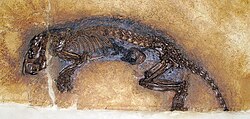This article relies largely or entirely on a single source .(November 2024) |
| Masillamys Temporal range: | |
|---|---|
 | |
| Masillamys at the Senckenberg collection | |
| Scientific classification | |
| Kingdom: | Animalia |
| Phylum: | Chordata |
| Class: | Mammalia |
| Order: | Rodentia |
| Family: | † Ischyromyidae |
| Subfamily: | † Microparamyinae |
| Genus: | † Masillamys Tobien, 1954 |
| Species [1] | |
| |

Masillamys is an extinct genus of rodent. It was named in 1954 by Tobien based on fossils found in the Quercy Phosphorites Formation, France. It is considered to be a sister genus to the Hartenbergeromys , Lophiparamys , Mattimys , Microparamys , Pantrogna , Sparnacomys , and Strathcona genera.